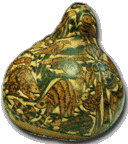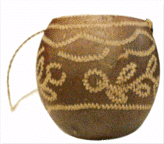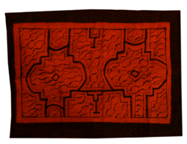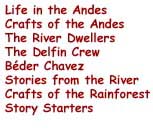

 Crafts
created by the people living in the rainforest reflect not only their way
of life but also what they believe about themselves and the plants and animals
that share the forest with them.
Crafts
created by the people living in the rainforest reflect not only their way
of life but also what they believe about themselves and the plants and animals
that share the forest with them.
The skills necessary for creating crafts are the same skills that people need to live in the forest. Being able to proficiently use a knife or hatchet to hollow out a tree trunk to make a canoe is not much different than carving intricate patterns on gourds or hard woods.
 Some
crafts are sold to shops in Iquitos. Others are traded directly with people
from other villages or with the tourists who visit the villages on the river.
Some
crafts are sold to shops in Iquitos. Others are traded directly with people
from other villages or with the tourists who visit the villages on the river.
Although villages closer to Iquitos deal mainly in soles, the local currency, people in more remote areas often prefer to trade for items that they can use. Instead of money, we offered tee shirts and baseball-type hats in exchange for local crafts to the people we met.
We were careful not to purchase carvings made from mahogany, an endangered tree and one that is protected within the Reserve.
Instead, the carvings we purchased were made from another reddish wood. It
is easy to tell the difference between the two woods because mahogany is much
heavier or more dense than alternative woods.
mahogany, an endangered tree and one that is protected within the Reserve.
Instead, the carvings we purchased were made from another reddish wood. It
is easy to tell the difference between the two woods because mahogany is much
heavier or more dense than alternative woods.
 Back
in Iquitos, a woman tried to entice us into buying some of her beautiful earrings.
Unfortunately, many of them were made from animal parts such as bone or feathers.
Instead, we bought a beautiful batik cloth. Why do you think so many of the
products are made from animals?
Back
in Iquitos, a woman tried to entice us into buying some of her beautiful earrings.
Unfortunately, many of them were made from animal parts such as bone or feathers.
Instead, we bought a beautiful batik cloth. Why do you think so many of the
products are made from animals?
Have you ever traded items with your friends or family? How do you know when you have made a "good" or "fair" trade?




